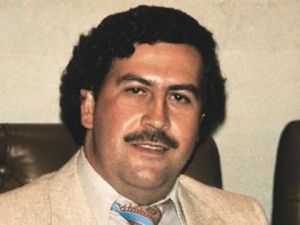Difference between revisions of "Pablo Escobar"
(Medellín drug cartel link) |
(Amnesty request) |
||
| Line 12: | Line 12: | ||
}} | }} | ||
'''Pablo Escobar''' was a wealthy drug kingpin who ran the [[Medellín drug cartel]]. In 1989, ''[[Forbes]]'' magazine listed him as the seventh-richest man in the world.<ref>http://www.npr.org/templates/story/story.php?storyId=9252490</ref> | '''Pablo Escobar''' was a wealthy drug kingpin who ran the [[Medellín drug cartel]]. In 1989, ''[[Forbes]]'' magazine listed him as the seventh-richest man in the world.<ref>http://www.npr.org/templates/story/story.php?storyId=9252490</ref> | ||
| + | |||
| + | ==Amnesty efforts== | ||
| + | In 2016, [[Christopher Woody]] of ''[[BusinessInsider]]'' wrote that the [[Medellin cartel]] had contacted [[Jeb Bush]] seeking an amnesty for to Pablo Escobar, believing that Jeb would ask [[GHWB|his father]] for an amnesty. He cites [[Patrick Clawson]] and [[Rensselaer Lee]]'s 1996 book, ''[[The Andean Cocaine Industry]]'' that "In 1988, the drug lords reportedly attempted to hire the services of the New York firm [[Kissinger and Associates]] to mount a public relations campaign on behalf of the proposed trafficker-government accord."<ref>https://www.businessinsider.com/pablo-escobar-medellin-cartel-jeb-bush-extradition</ref> | ||
==Search Bloc== | ==Search Bloc== | ||
Revision as of 08:25, 11 January 2019
 Escobar circa. 1980 | |
| Born | Pablo Emilio Escobar Gaviria 1 December 1949 Antioquia, Colombia |
| Died | 2 December 1993 (Age 44) Medellín, Colombia |
| Victim of | murder |
| Supposed perpetrator of | Avianca Flight 203 |
Pablo Escobar was a wealthy drug kingpin who ran the Medellín drug cartel. In 1989, Forbes magazine listed him as the seventh-richest man in the world.[1]
Amnesty efforts
In 2016, Christopher Woody of BusinessInsider wrote that the Medellin cartel had contacted Jeb Bush seeking an amnesty for to Pablo Escobar, believing that Jeb would ask his father for an amnesty. He cites Patrick Clawson and Rensselaer Lee's 1996 book, The Andean Cocaine Industry that "In 1988, the drug lords reportedly attempted to hire the services of the New York firm Kissinger and Associates to mount a public relations campaign on behalf of the proposed trafficker-government accord."[2]
Search Bloc
In late 1989, after a series of bloody humiliations dealt by Escobar to the forces and officials of the Colombian government, the then-President Virgilio Barco created a special police unit to deal with the kingpin and his cartel.
While its initial encounters with the Medellín network left the Bloque de Búsqueda, or Search Bloc, dazed and weakened, it eventually became a hardened task force that hunted down Escobar and his associates.
Assisted by US special forces, US Army intelligence, as well as members of the CIA and DEA, the Search Bloc pursued Escobar throughout 1992 and 1993. According to official accounts, it was the Search Bloc that ultimately killed Escobar.
Murder
On 2 December 1993, he attempted to flee from a hideout in his home base of Medellín, Colombia, by scrambling across a neighbouring rooftop, but was cut down by gunfire, and the resulting image has been seared into the public memory — the bloody corpse of the world’s most powerful drug lord splayed across a tile roof in the city that was once his safest redoubt.[3]